Your sales funnel should focus on customer retention
When I look at most sales funnels, I imagine a bunch of marketers running a marathon. They’re racing to the finish line, jogging through the awareness and consideration stages, and then rounding the decision stage of the buyer’s journey. At long last they burst through a huge end-goal banner labelled “THE SALE.” Then it’s all high fives, champagne showers, and sweaty congratulations.
But a sale shouldn’t be the end goal of your marketing campaign. In fact, it’s only half finished.
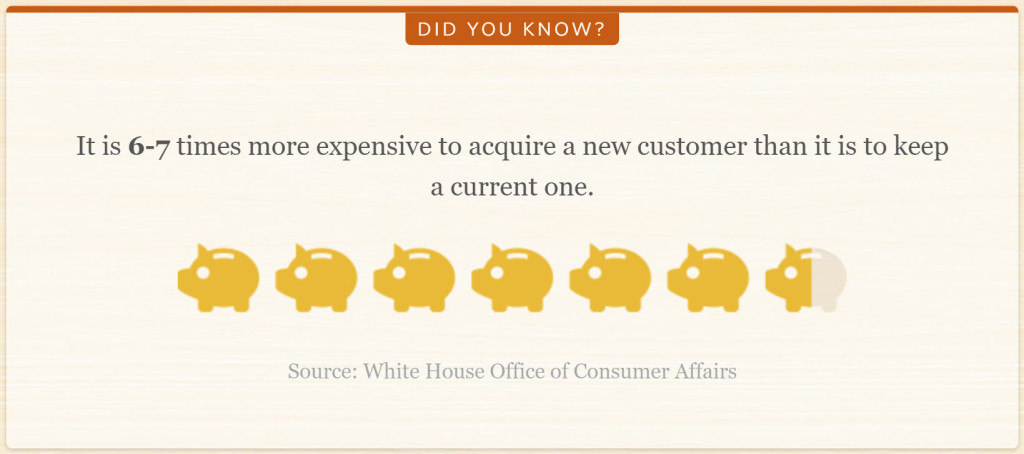
A sales funnel without a retention stage is missing the entire last leg of the buyer’s journey.
While this may seem trivial, this visual representation of the sales funnel is how a lot of marketers conceptualise the sales process. When your sales funnel factors into your budget plans, pretending that marketing stops at the sale—and consequently devoting your entire marketing budget to hooking customers in the early stages of the buyer’s journey—does you and your business a disservice.
Plus, retention is the most important stage of the buyer’s journey, because:
- Customers who have a great experience with your company are 7x more likely to try new offers, buy from you again, and forgive your mistakes. They’re also 8x more likely to trust you in the future and 9x more likely to refer you to a friend. (Temkin Group)
- Acquiring new customers costs you 6-7x more than retaining current customers. (SignalMind)
- A 5% increase in customer retention increases your profitability by 25–95% (Bain & Co.)
- The lifetime value (LTV) of loyal customers is up to 10x higher than their first purchase. (HelpScout)
- Repeat customers spend 67% more than new customers. (BIA/Kelsey)
- Bringing a new customer up to the same profitability as a loyal customer you’ve lost costs you 16x more. (Marketing Tech Blog)
- Failed customer retention, due to lousy customer service alone, costs UK businesses £12 billion every year. (Our Social Times)
So we know (and have known for years) how important customer retention is. And yet the Content Marketing Institute’s 2016 Benchmarks, Budgets, and Trends report tells us that more UK marketers still prioritise sales over customer retention and loyalty.
How do you remedy this? You make retention-focused content marketing part of your business plan.
For example, Kane Jamison, founder of Content Harmony, talks about how his company uses an hourglass sales funnel that widens out after initial conversion. As he says, “the crucial final step, customer retention, is actually an area for growth as opposed to diminishing value over time … [the hourglass funnel] demonstrates that a healthy customer satisfaction and loyalty effort will grow your business, as satisfied customers evangelize your business and return for more services.”
How to use content marketing to increase customer retention
You’re probably well aware that quality content marketing is key to engaging new customers, earning better rankings on search engines, and converting new leads, but fewer people talk about content strategies aimed at retaining existing clients. To rectify that, I’ve compiled four content-focused tactics that will help you retain customer interest even after you’ve landed a sale.
1. Publish quality content on a regular basis
The best-practice strategy that practically everyone can recite (even if they can’t accomplish it) is that you should publish new content regularly. You do this to keep your website constantly updated and to add continuous value to your users’ experience, which should entice them back for more.

The Met Office’s Twitter account is an excellent example of constant audience engagement / re-engagement through consistently high quality publishing
Frequent content updates often come in the form of blog posts, but don’t let that stymie your creativity if you want to take a different route—FAQs, how-to guides, product demos, product reviews, video announcements, vlogs, podcasts, Google Analytics reports, and curated lists all make for great short form material.
Of course, publishing content on a consistent basis is easier said than done. If you’re struggling to keep your site fresh, consider the following strategies:
- Pencil it in – Set aside an hour or two each week to produce some content. Keeping a schedule might make all the difference.
- Pre-plan content – Brainstorm 20-30 topics at a time, so that you can start writing without having to brainstorm new topics each time you start a new blog post or podcast.
- Hire a guest blogger – When you find other industry authorities that share similar views, invite them to blog on your website. This gives you a break and you benefit from another’s authority.
- Repurpose content – Take one big asset and milk its research for all it’s worth. Break down stats, showcase surprising findings, and recap your research in podcasts and blog posts—you’ll be able to make one asset stretch a long way.
2. Improve your on-boarding
According to Preact, a SaaS company, the two leading causes of churn are poor onboarding (23%) and underperforming products (20%). If you’re confident in the quality of your product, then it might be time to review how customers interact with your product immediately after purchase.
Smoothing out your onboarding process is especially important for software companies, whose offerings might have a learning curve or unintuitive features. There are a few strategies for dealing with this, but popular options include portals that answer any and all questions your users have and email campaigns to orient new users.
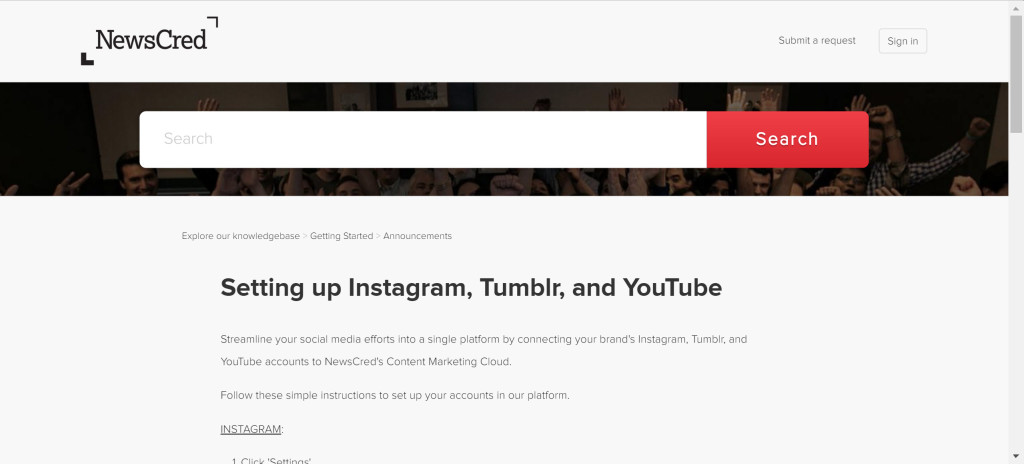
For example, NewsCred has a “Supportal” feature which walks new users through their software and answers frequently asked questions. Outbrain takes the second strategy—they frontload all of their educational content through an automated email campaign called “Brainiac Bootcamp.” They’ve even tested specific features and measured them for higher retention rate, in order to better appeal to their target audience.
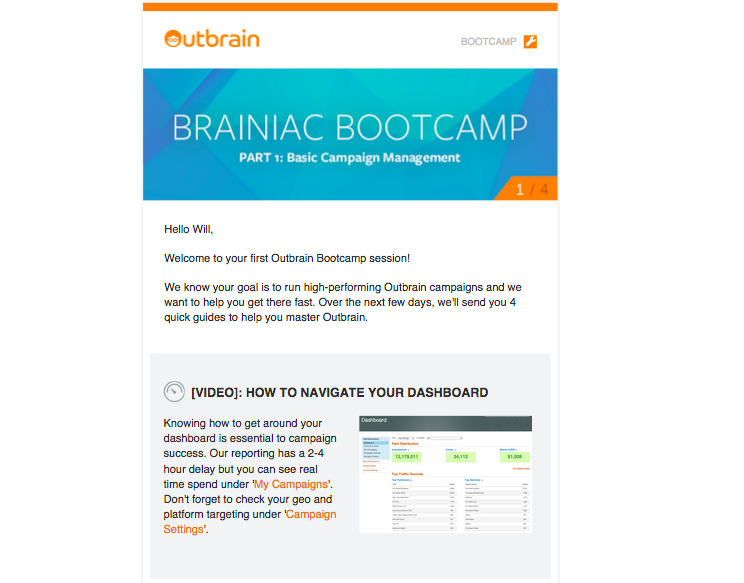
No matter which piece of content you use to ease your onboarding process, make sure it addresses your audience’s pain points and overcomes and barriers to entry that might scare them away from adopting your product. Customers will usually provide feedback if you request it, so use that data to improve your process. Even simple barriers to entry, like a lack of clarity on how a product might be used at purchase could cause a problem.
Retailers can develop their product page listings with how to use instructions. Espares.co.uk do an amazing job of this in their product pages with video content, but you can provide very simple “how to use” instructions in your product copy like this simple listing on Amazon. A follow-up “thank you for your purchase” email should contain similar cues and of course, request feedback to make the process even easier.
3. Keep your audience informed
Whether you’re launching an email marketing campaign, publishing e-newsletters, maintaining a blog, or just updating your site’s news, one of the best ways to stay relevant is to turn yourself into a one-stop shop for all news relating to your industry. Stay on top of current trends and advancements and let your audience know what’s new and exciting in your field. This will also help you stay ahead of the curve.
Email campaigns are the quintessential pieces of retention content here. They can be highly personalized to appeal to users at any stage of the buyer’s journey. They can specifically target different segments of your customer base, such as new customers, recently churned customers, or loyal customers. And, when automated as part of a drip campaign, they don’t take a huge time investment.

UK chocolate distributor Cocoa Runners have a regular email campaign of valuable insights, course offers and chocolate suggestions.
Email marketing campaigns also let you keep your content flexible. You can include promotional information, engaging product highlights and features, news about recent and upcoming changes, or any discounts that might entice disengaged users back into the fold. If you’re not currently using an email marketing strategy, there’s no time like the present to start.
4. Make your audience’s lives easier or more entertaining.
Depending on your area of expertise, a great way to stay relevant with your users is to develop an app, extension, or plug-in for your users to download. This might be something simple, such as a news app that publishes the same updates you post on your website, or it might have more utility, such as a Chrome extension that allows marketers to geographically filter their search results.
Or, if software is your company’s core offering, make sure that it’s always up-to-date and constantly being improved to add continued value to your customers. The goal is to keep users engaged with your brand so that they don’t seek out a competitor’s solution.
As in all aspects of content marketing, the key here is quality. Make it useful or entertaining so that your users will think of your brand and want to share it. Who knows, these pieces of content might even be popular enough to become your core products down the line (e.g. Dropbox, Skype, and Snapchat).
5. Engage with your audience
Content can be as simple as a tweet, a reply to a blog post, or a shout out on your Facebook page. One of the most important elements of customer retention is simply making sure that your customers feel heard. So go ahead, hop on social media. Tweet out new developments. Share industry news that excites you. Respond to every comment that doesn’t sound like a spam bot.
And don’t underestimate the value of bringing back some of your initial engagement content here—even loyal users love a good contest.
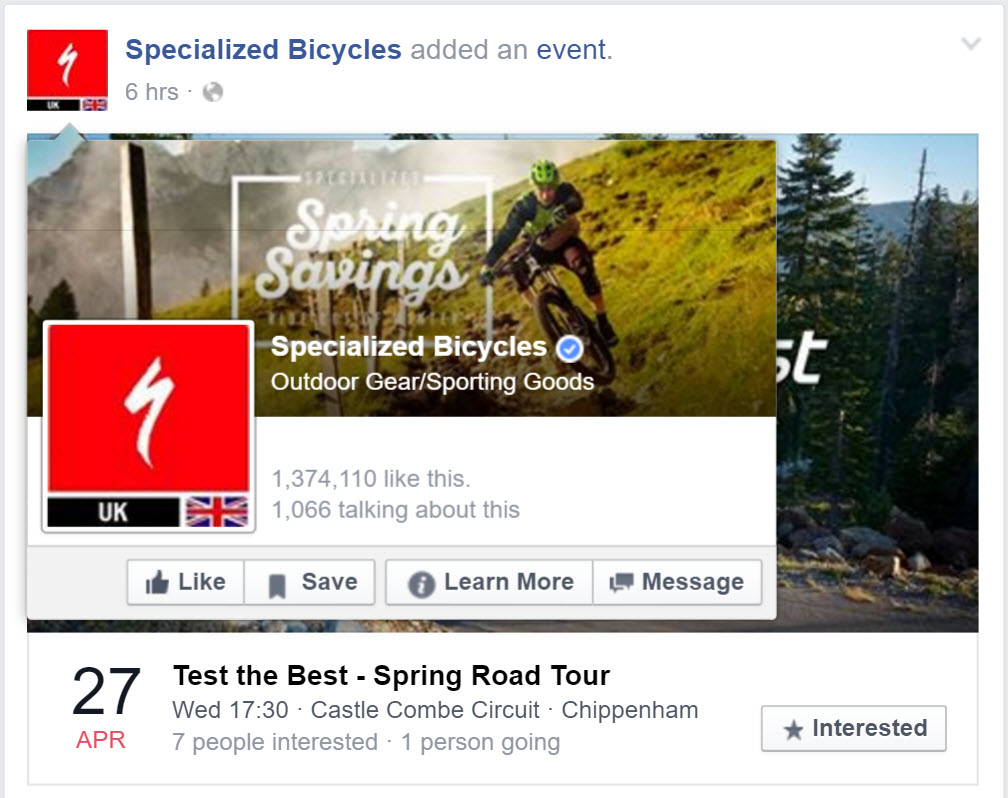
Along with sales offers, how to videos, sporting updates from sponsored riders and the works team, Specialized host events across the UK for new and existing customers to ride their products
Also, make sure you address complaints quickly and professionally. How you handle adversity will not only affect whether or not that client shops with you again in the future, but it will influence the purchasing decisions of every other user who reads that negative review.
When you stay connected with your audience, you show that you care about them, not their wallets.
Customer retention starts with a positive customer experience
At the end of the day, the most important part of customer retention is giving them a reason to return in the first place. Your website needs to be intuitive and responsive, transactions need to be seamless, and customer service needs to be impeccable.
And, of course, your content needs to be valuable and informative.

Wiggle offer expert guides and repeat purchase awards to retain their customer base
Your customers should never have to guess at the details they care about. Be transparent with content like price guides, demos, and product specs—if you reward your customers with a good experience, many will want to pay that goodwill forward in the form of reviews and star ratings.
Social proof is your greatest ally when it comes to retaining customers and winning new leads. This word-of-mouth endorsement is the best kind of promotion—it will encourage old customers to revisit you and new customers to take a peek.
As my partner, Joel Klettke, says, “As far as social proof goes, there’s nothing that packs quite the same punch as a well-placed story from a satisfied customer.”
For more great advice on how content marketing can facilitate customer retention, check out this articles by Outbrain’s Miko Levy.
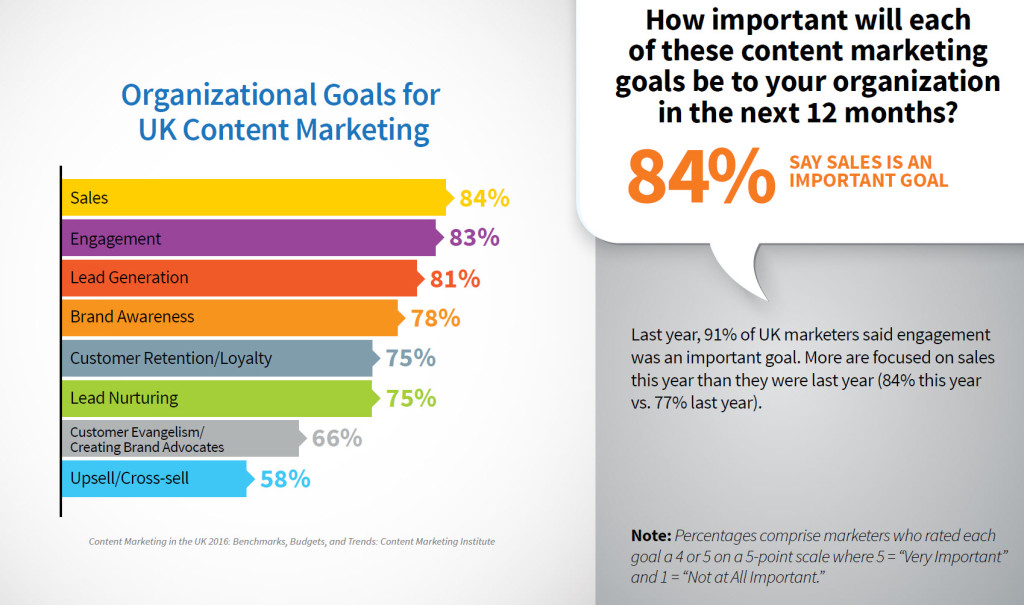

Jared Hoffman
Great read, I’m not sure I’ve considered customer retention to this extent in the past. In my experience it’s often been a “it would be nice if they came back” sort of approach. This has definitely opened my eyes to some of the things I’ve been doing wrong in the past.
Question for you, do you feel the examples you provided here are primarily B2C focused or should these practices be fairly universal for B2B as well?
Thanks for a great post!
Richard Baxter
Hey Jared, great point on the B2B angle. They’ll be differences in the data collection methods (customer satisfaction survesy vs say, data derived from support tickets raised in zendesk) *and* each vertical in B2B different so you need to assess individually too. The solutions might be similar though – FAQ’s, enhanced product copy, how to guides and videos – it’s all about appropriateness of targeting, really.
Hope that helps!
Steven Peters
Thanks for the read, Jared. And thanks, Richard, for the great response. I’ll add my two cents to the insights Richard has already provided:
I truly believe both B2B and B2C businesses will benefit from the content mentioned above (blog posts, video series, FAQs, how-to’s, etc), and most of the strategies I provide (publishing schedules, email campaigns, addressing complaints quickly, etc) apply to both.
But B2B and B2C business do need to tackle different challenges. For example, B2B needs to overcome objections to higher price points and sell themselves on the strengths that will make them last through budget cuts and longer buying cycles.
No matter who you’re selling to, remember that the content you produce is never about you. It’s about your customer. If you’re selling to other businesses, make sure your content specifically targets them and addresses their pain points.
nandu web
The most popular use cases for content marketing tend to sit in two distinct areas: customer acquisition and sales enablement. Very rarely do marketers ever discuss the merits of using content for what is arguably the most important business activity of them all – customer retention.
I truly believe both B2B and B2C businesses will benefit from the content mentioned above (blog posts, video series, FAQs, how-to’s, etc), and most of the strategies I provide (publishing schedules, email campaigns, addressing complaints quickly, etc) apply to both.